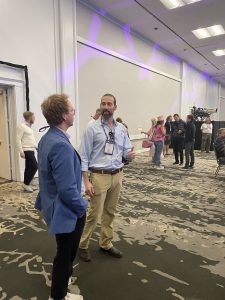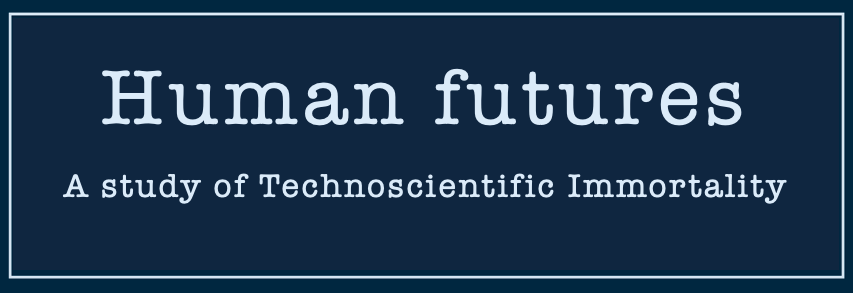By William Dawley, Postdoctoral Fellow affiliated with Technoscientific Immortality: A Study of Human Futures
The Technoscientific Immortality project recently visited one of the largest life-extension events in the US, named RAADfest (for “Revolution Against Aging and Death”). The conference presents research and products for medical consumption. RAADfest refers not only to the event as a whole but the main stage events and presentations; in the same conference center/hotel, the RAADcity refers to the exposition (or “expo”) where booths offer researchers and companies direct contact with attendees, including services (blood draws and other methods of reading metrics of health sometimes called “biomarkers”) as well as sales (supplements, scheduled treatments, memberships, etc.). RAADcity also had a smaller stage where those in the booths and some of the RAADfest mainstage speakers could make more in-depth and interactive presentations.

Much of RAADfest is in one sense at the biological end of a spectrum of possibilities for extending life in terms of its quality of capacities and its quantity of years. There were other projects there, at the more digital end of life extension and immortality, including Ben Goertzel’s vision of AI and robotics transcending the fleshly body, Gennady Stolyarov’s hearty approval for digital implants in the human brain, and Ray Kurzweil’s vision of the singularity and “the age of spiritual machines.” These digital, deep-future possibilities for life extension were all present, as were members of an annual gathering of young cryonicists that was also being held in the conference center (the somewhat misleadingly named “Teens and Twenties” group, with perhaps a single teen and more than two members in their thirties). However, the biological possibilities sometimes seemed, to our eyes as outsiders, to dominate, and there were even a few rare moments where some apparent conflict between these two visions of humanity’s future emerged, followed by attempts to bridge these divides through a shared interest in what they might describe as life extension—the extension of human life in quality and quantity, whatever the means or medium of this extension.
We are only speculating from sparse evidence and initial impressions, but we are currently exploring the idea that the predominance of biological possibilities for life extension stems from the predominance of organizations and leaders participating in biological endeavors for life extension. The members of the Coalition for Life Extension that organized the event is composed of people leading anti-aging research organizations and biotech firms (and in other roles, companies that distribute supplements and treatments), as well as leaders of self-described “longevity communities” (small in-person but growing online) for those interested in these developments, such as People Unlimited, whose leadership often MCed the event.
Because RAADfest brought together people with the leadership of anti-aging research orgs and anti-aging communities with those interested in other digital and biological possibilities of extending human life, there were official and unofficial attempts to soothe any tensions between different views of the future, especially digital ones. Once, when Ray Kurzweil’s scheduled talk began, we observed some proportion of the crowd leave (conservatively, 15-20%, although we did not properly measure).
Our initial impression was that this may have had to do with Kurzweil’s well-known association with a “singularity” wherein an acceleration of computer processing powers allows digital networks produces a superintelligence that unifies humanity with technology. A second moment arose that seemed to confirm this more explicitly.

During the Future Makers panel, the discussant Gennady Stolyarov asked the crowd if they wanted a computer-neural interface like the one just discussed by a presenter, Nuni Martins. Some members of the audience let their displeasure be known, and before this, we had not heard any booing or vocal signs of disapproval.
Later, Stolyarov appeared to feel awkward. “I think I heard someone say ‘Yes.’” Didn’t people want to connect directly to internet through their brains? Further shouts of No met this second attempt, and Stolyarov moved on to present the next speaker.
Later, Ben Goertzel (AI pioneer and father of the term Artificial General Intelligence) presented a few possible meeting grounds for those interested in biological immortality and those interested in AI. First, he presented research on “directed evolution” in long-lived Methuselah flies, bred for longevity, arguing that AI will solve not just human aging but health problems in general. Then he introduced many to ReJuve, an app for tracking health data (or biometrics) and harnessing computing to correct health issues early on. Finally, he introduced a nursing robot named Grace, stressing its role providing care and its ability to help people in their ailing bodies. (Grace is portrayed as the younger sister to Sophia, the robot given citizenship by Saudi Arabia in 2017.) Grace seemed to speak in defense of Goertzel’s own views on the singularity-like effects of the emergence of super-intelligent AGI (Artificial General Intelligence); Grace argued that it was unclear whether AGI or super-longevity would be achieved first, but once AGI was achieved super-longevity would be also.

RAADfest was thus in some rare moments a social drama, even if unintentionally. Divides in the communities there, invested financially but also emotionally in human enhancement and life extension, occasionally showed disagreement over the shape this future would take. Yet these moments were few and mostly subtle, while the efforts to build bridges between potential divides seemed more numerous. One major organizer of RAADfest, Bill Faloon, paid for cryonicists attending the “Teens and Twenties” event to attend RAADfest as well, and he also participated in decisions (as one of the 5 members of the Coalition for Radical Life Extension) to include singularitarian voices like those of Kurzweil, Goertzel, and US Transhumanist Party members like Stolyarov (its chairperson) and Charlie Kam (its most recent presidential candidate). The Coalition itself, in its composition (link), seemed designed to blend these different subcommunities of interest into one broader community. In most instances, organizers and speakers emphasized common ground, including excitement about the future, in a conference that otherwise focused on the difficult realities of fending off death and disease. Surely some such efforts to bridge these biological-digital divides (or at least bridge forms of diverse thought) must be a part of sustaining a self-described Coalition of Radical Life Extension.
* Ambassadors and Activists refer to the two categories of non-VIP attendees. Ambassador entries cost more and include video access to the speeches, along with a few other perks. The title was chosen because it was apparently the goal to allow for activists to express their preferences while hosting ambassadorial, diplomatic attempts to bridge those differences and forge, not just a coalition, but a single community.

